August in the Garden
in the United Kingdom
So far, August in the UK has been fairly wet and cool. Although this is a relief after the hot, sultry weather we had a few weeks ago, it means that everything in the garden and at the allotment (including the weeds) has grown at a remarkable rate. So whilst it would be very nice to be looking at sunflowers against a blue sky, as in the picture above, unfortunately, the colour of the sky is quite grey at the moment!
But it’s not all bad. There’s a lot to enjoy in the garden. Although the roses have all but finished (as well as delphiniums, lupins, and foxgloves) rudbeckias, hollyhocks, echinaceas, and phlox are now coming into bloom. Some of the salvias have finished blooming, but the wonderful “Amistad” is now flowering in all its purple glory. Each year I think I’ve lost it to the frost, but each year it comes back again, albeit quite late in the Spring.

Salvia “Amistad”
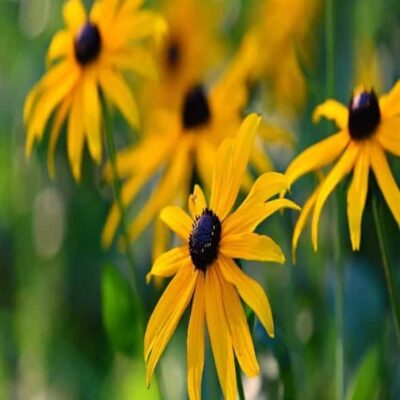
Rudbeckia
Clematis
And the viticella clematis is coming out. I’m trying to grow a clematis for every season of the year, but I think the viticellas are my favourite. Apparently, they are less subject to clematis wilt than their larger flowered cousins. They are very vigorous and long-flowering and can reach up to 10-15 ft.

Clematis viticella
The Allotment
As I’ve mentioned in a previous blog, our garden tends to be quite shady, partly because of the large yew trees that grow along the length of one side. For this reason, there aren’t too many places where we can grow sun-loving perennials, such as echinaceas and salvias. A far better place for these is our allotment which is open and sunny and has good, loamy soil which has been well worked over the years.
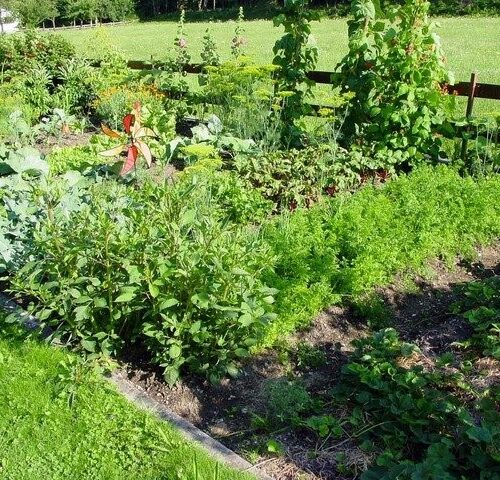
National Allotments Week
So I thought I’d talk a little bit about the allotment this month, especially as it’s National Allotments Week this week in the UK (as declared by the National Allotment Society!)
There are various online talks during the week, which you can register for in order to receive a link to attend them via Zoom. These will be recorded and made available later.
Brief History of allotments in the UK

Allotments in the UK go back a long way with evidence pointing back to Anglo-Saxon times. In 1908 the Smallholdings and Allotments Act came into force, placing a duty on local authorities to provide allotments according to demand. However, the 1925 Allotments Act established statutory allotments that local authorities could not sell or convert without Ministerial consent.
During the Second World War, allotments came into their own because of the necessity of providing homegrown food for the population at a time when importing food was difficult or impossible. The “Dig for Victory” campaign encouraged people to grow their own fruit and vegetables and land was acquired to provide extra allotments for this purpose.
Interest in growing fruit and vegetables declined in the 1950s and 1960s, and many allotment sites were sold off for building. However, the 1970s brought a renewed interest in self-sufficiency and allotments came back into their own again. Today, with a new awareness of food miles and organic growing and helped by television programmes such as the BBC4 series “River Cottage” more and more people are applying for allotments. This has particularly been the case during the COVID pandemic when people spent more time at home and became interested in growing their own fruit and vegetables. There is also a realisation that allotments can, as they did during the Second World War, make a real contribution to the UK’s food needs.
Today there are an estimated 300,000 plot-holders across the UK, and there are another 100,000 on waiting lists, which can sometimes be decades-long.
What is an allotment?
An allotment, according to the National Allotments Association, is
“…an area of land, leased either from a private or local authority landlord, for the use of growing fruit and vegetables. In some cases, this land will also be used for the growing of ornamental plants, and the keeping of hens, rabbits, and bees. An allotment is traditionally measured in rods (perches or poles), an old measurement dating back to Anglo-Saxon times. 10 poles are the accepted size of an allotment, the equivalent of 250 square meters or about the size of a doubles tennis court.”
We have a quarter plot, so our allotment is not very large. This means that we have to be quite careful about what we want to grow on it, especially as we want to practice crop rotation. So the area where we have grown potatoes this year can’t be planted with potatoes next year, and we don’t have another space that is large enough. We may have to resort to growing them in bags.
When we took it over the allotment was covered in weeds and there was no storage for tools. Last year we spent most of the time clearing the weeds and also put up a shed. There was already an old bath on the allotment which gathers water and a wooden planting box.
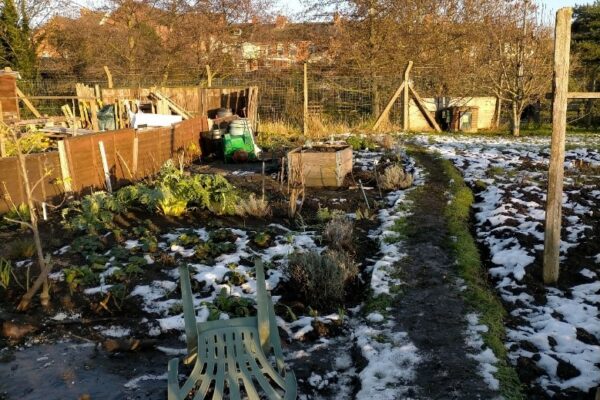
December 2020 after clearing most of the weeds
One of the first things we did earlier this year was to put up a shed and to paint it and the planter that was already on the plot bright blue. There’s no mistaking which one is ours!
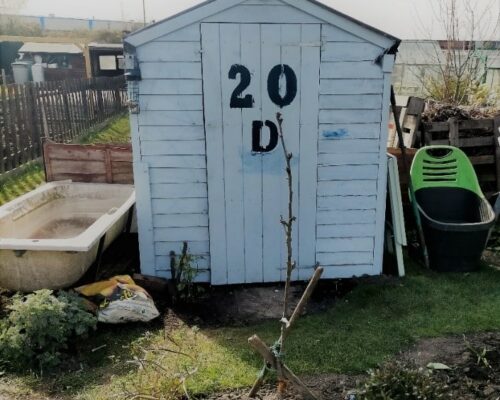
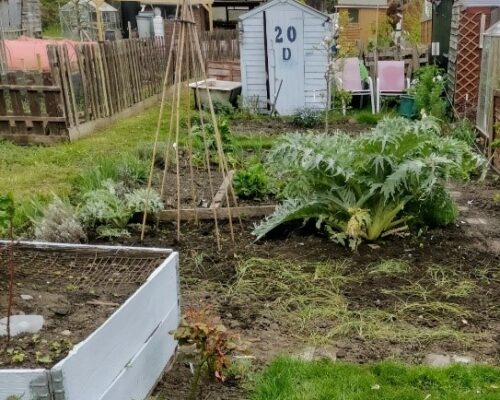
Crops
We decided to grow, as far as possible, permanent crops like fruit bushes and trees that would not require as much watering. So we have an apple tree, a plum tree, and a pear tree as well as strawberries, honeyberries, raspberries, and rhubarb. The artichoke and asparagus are also permanent. As an experiment, we decided to grow saffron, the most expensive spice in the world. Last year we planted about 100 bulbs in September, and we actually had a few flowers in October from which we carefully extracted the stigmas, the part of the plant used for the spice! This year we are hoping for more as the corms increase in size. Whether we will make our fortune from it is another matter!
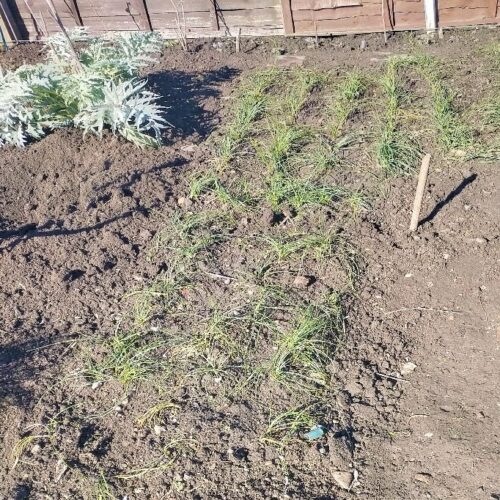
The saffron bed, October 2020
Apart from that, there are various herbs that are permanent, such as rosemary, thyme, sage, marjoram (5 different types), angelica, lovage, rue, and nepeta.
In what is left of the plot we have grown two different types of potato (Première and Charlotte), garlic, beetroot, squash (Pattypan and Butternut) climbing French beans, radishes, lettuce, brassicas, turnips, leeks, and cucumbers. So far, we have harvested garlic, potatoes, radishes, beetroot, cucumber, and beans. Where the potatoes were we have planted kale, celeriac, cabbage, and kohlrabi – mostly for the winter.
Still to come this summer is the squash and the tomatoes. There are a lot of tomatoes in the bushes, but most of them are still green. I’ve done some online research about the reasons for this, and it seems that tomatoes like the consistency of watering and temperature, and they have had neither this year. We can only hope for a heatwave at the end of August, otherwise, there will be an awful lot of green tomato chutney being made!
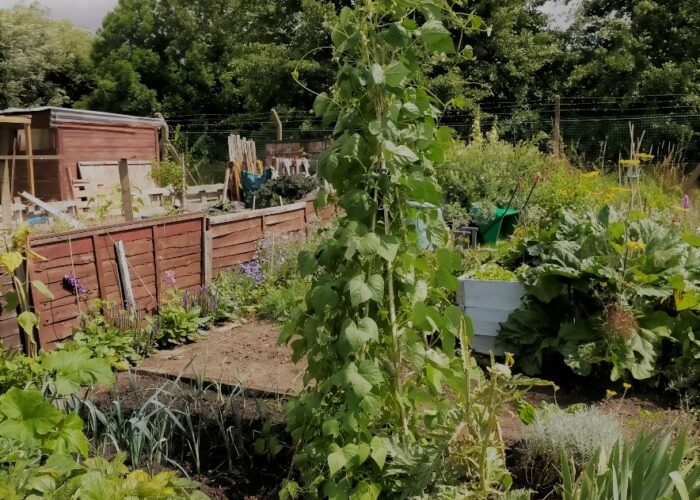
Flowers on the allotment
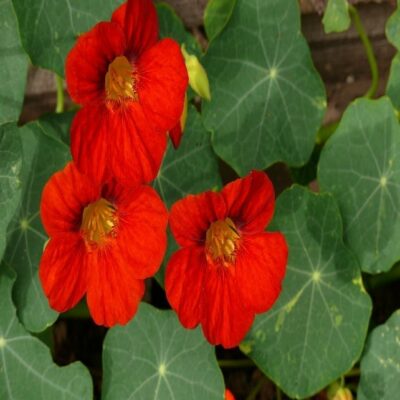

Although growing flowers on the allotment were at one time discouraged, this is no longer the case, and the benefits of flowers in terms of attracting pollinating insects and insects that help to get rid of predators are well recognised. There is a long list of beneficial flowers which includes cornflowers, calendulas, poppies, echinaceas, Sweet Williams, hollyhocks, eryngiums, achilleas, scabious, campanula, Limnanthes Douglasii, and foxgloves. In addition, certain plants act as good companions to other plants – marigolds planted next to tomatoes, for instance, helped to repel insects such as whitefly. Nasturtiums are used as “sacrifice plants” near beans because they attract the blackfly which would normally attack the beans.
There is a list of plants for pollinators on the RHS website which is reviewed once a year by RHS staff
There is a useful guide to companion planting on the “English Garden” website:
We have an area that has been given over to flowers, both annuals, and perennials, but flowers grow all over the allotment among the fruit and vegetables as well. There are several plants that are highly attractive to bees, notably lavender, borage (which self-seeds), and phacelia, which I grew as green manure but hadn’t the heart to dig in until it had finished flowering, as the bees absolutely loved it.

Borage
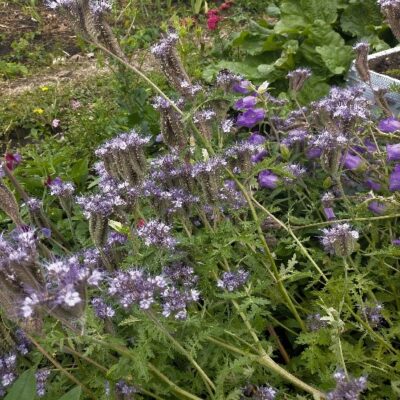
Phacelia
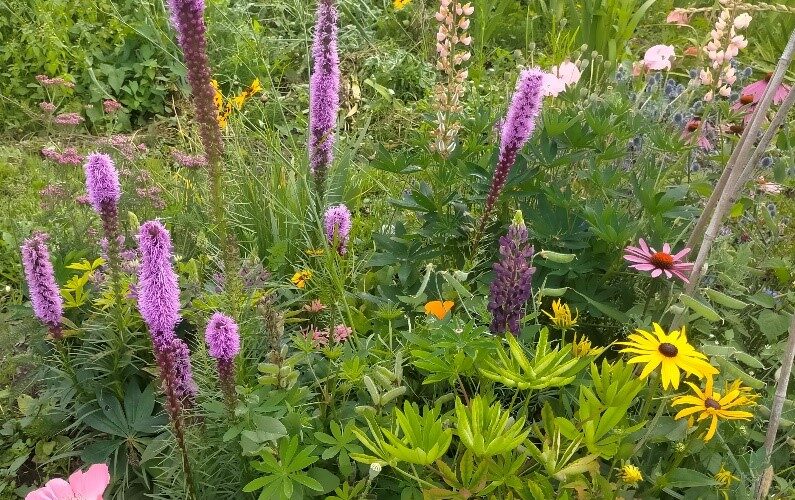
Enriching the soil

Comfrey
We’ve been far and wide to try to find a good source of well-rotted horse manure to spread on the allotment, but so far haven’t found the ideal place. Meanwhile, we have two compost bins on the allotment and three at home and all the green kitchen waste and plant waste (apart from perennial weeds) go in there, as well as shredded cardboard used kitchen towels, and shredded newspaper. We grow comfrey both on the allotment and in the garden and add this to the compost bin. We also use it to make comfrey tea, which, although it smells horrible, does no end of good to the plants – and it’s free!
To spray or not to spray
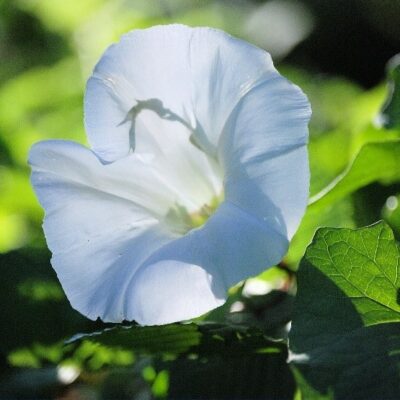
One advantage of growing your own fruit and vegetables is that you know whether they have been subjected to any chemicals. We try, as far as possible, not to use weedkillers or insecticides – although at times it’s very tempting. We have a particular problem with bindweed which is almost impossible to eradicate. No matter how much you dig it out, a tiny piece of it will remain and regrow. The non-organic way to deal with it would be to use Glyphosate, but its use is controversial, and, anyway, such a vast amount would be needed for even a small allotment like ours, so it probably isn’t worth it. In the end, we have to live with it and just dig it up whenever we see it, especially when it winds its way around plants and strangles them. And the flowers are quite pretty!

Conclusion: Are allotments a good idea?
There’s no denying that allotments are hard work. There’s a lot of digging, manuring, weeding, cutting back, and watering, and there’s often a lot of rubbish to get rid of. Not everything can be composted! Not everything you grow is a success. There are pests and predators to contend with, not to mention the various diseases that can strike plants. And, if a crop is successful, very often you have a glut of it and then have to either live on it for a few weeks or give it away to other people. Courgettes are a case in point. When there’s a good crop, people almost beg you to take them off their hands!
It’s debatable how much money growing your own crops saves. People who don’t grow their own food will often tell you that it’s cheaper to buy fruit and vegetables in the shops. They may be right in some cases, but there is no substitute for the taste of vegetables or fruit that you’ve grown and cooked yourself. They are not only fresher, but they are better for you, as there hasn’t been a long delay between them being picked and put on the plate. And there is the opportunity to grow varieties of fruit and vegetables that aren’t normally available in the shops. This year I’m trying cucamelon: I’m not sure yet whether it will be a success, but it’s interesting to grow!
Having an allotment is good exercise, with the added benefit of being out in the fresh air. It’s not only good for you physically, but gardening has been shown to be good for your mind as well. And there is a social aspect to having an allotment, too. An allotment is a community of people from all walks of life, and most of them are happy to share tips, skills, and experience – and very often, seeds, plants, and equipment as well. Many have allotment associations that arrange social events such as barbecues, annual shows, and sales of plants.
So, all in all, I do think allotments are a very good idea – in fact, I think there should be more of them. To quote Phil Gomersall, Chairman of the National Allotments Association,
“Allotments have always been a healthy recreational pastime, but they have been a real godsend for thousands during the coronavirus pandemic. The benefits of working an allotment have really come to the fore.
“Perhaps now planners may heed what many in the community want and councils may start to fulfill their legal obligations to provide more allotments where there is demand.”
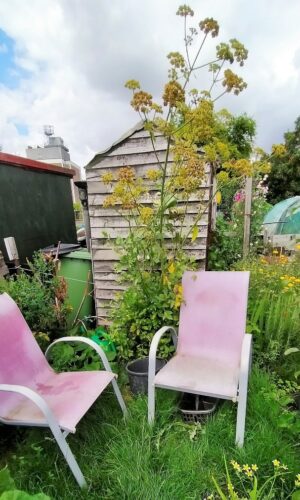
And sometimes you just need to sit down!

About the Author
Caroline Bowman has been hooked on gardening ever since she grew some thyme from seed and planted it in a window box when she lived in a flat in London. Fifty years later she is still hooked on gardening, but now she lives in Lincolnshire in England where they have quite a big suburban garden as well as an allotment, where they grow fruit and vegetables. Caroline loves flowering plants, in particular herbaceous perennials and she likes finding out about the more unusual varieties that will do well in the English climate and soil.
Caroline is writing for Gardenize and you can read her article about “To Do in March” here.
More from Gardenize
Images published on the Gardenize website belong to Gardenize AB and may not be used without permission.



